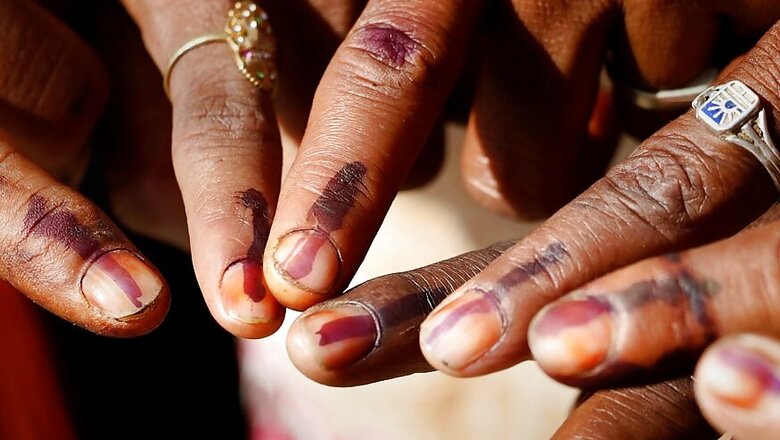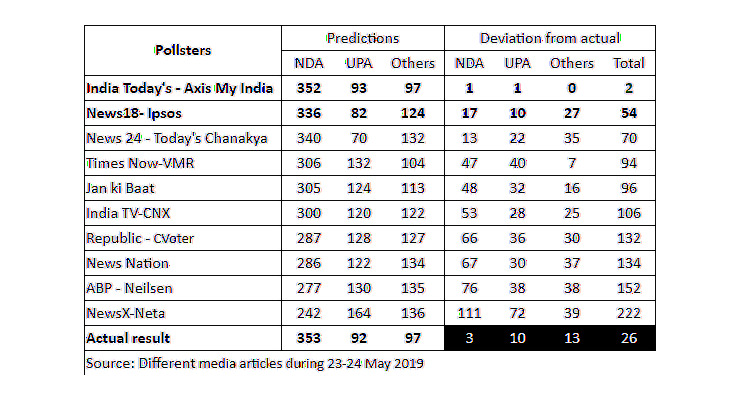
views
The News18 exit poll survey was conducted by Ipsos, the world’s most credible research agency that boasts a solid track record of predicting the electoral results of several elections around the world with high accuracy.
Ipsos India once again proved that in 2019 general election and stood out as one of the most accurate agency in predicting different key aspects of the poll.
Here is a comparison of predictions from different pollsters on three key indicators (seat predictions for NDA, UPA and Other) and how much each deviated from the actual:

The agency names are sorted as per their accuracy level i.e. the least to max total deviation (in the last column). It clearly shows that Ipsos is one of best on accuracy and in fact in second position. Some agencies in lower ranks have deviated as much as three-digit level on these three key indicators.
Apart from the accuracy in seat prediction, Ipsos was also bang on in predicting vote share. Ipsos predicted the NDA vote share as 48.5% and the provisional data shared by EC also confirms that actual vote share of NDA is 49%.
Ipsos had a very detailed and meticulous plan to make it a success, in each of the three critical stages, i.e. Planning, Execution and Analysis.
PLANNING STAGE
This is the most crucial stage to set things right at the first place. Ipsos’s rich global experience of conducting political polling in different countries of varied complexities across the world was leveraged to ensure nothing is left on chances. Scientific sampling was a crucial building block of success.
First the parliamentary constituencies (199 in numbers) were selected using Stratified Random Sampling technique. To select 796 assembly constituencies within these 199 parliamentary constituencies Ipsos used Simple Random Sampling. As many as 4,776 polling stations were selected using Systematic Random sampling. Time-location cluster sampling was done at polling stations level to ensure different demographics and every third (or fifth person in some high traffic PSs) person was approached to avoid group biases.
EXECUTION STAGE
All plans were religiously followed. It was a pure exit poll methodology, unlike some other agencies who mixed it with shortcuts like post-poll, online, telephonic, mobile app etc. and still called their work as exit poll.
Survey was conducted on voting day in all seven phases of the polling and only on those days in pre-decided polling stations. This ensured that voter were still in the same frame of mind after voting and no influence had happened.
All interviews were done using tablets. Power banks were provided to each interviewer to ensure no compromise on time-location cluster sampling. The tablets had EVM simulated on it and the respondents pressed the option without the knowledge of the interviewer. This helped in capturing unbiased response.
The massive interviewing exercise was done by Ipsos’s in-house data collection team which is one of the largest in the country. The fieldwork was monitored from four regional control room and one national control room.
A team of about 35 QC executives conducted concurrent quality checks on the interviews before accepting or rejecting the data. Live monitoring, data on real time basis and GPS-enabled devices had also ensured the quality of field work. In addition to this, learning of every phase were implemented in next phase of election. Team had pre-empted likely on-ground challenges and thereby risk assessment and mitigation strategies were planned accordingly.
The data was then weighted by age, gender, religion and caste to make the sample representative of each parliamentary constituency. Further, deep dive into the exit poll results with a detailed analysis of voter mood, trends and factors were considered using mathematical models to arrive at vote estimates and seat predictions.
The core research team of Ipsos travelled extensively in different parts of the country during these 5-6 weeks, which helped them in understanding the pulse and underlying issues at different parts. Different possible biases, like Bradley effect (people not sharing honest data due to social/political reasons of embarrassment or fear), were also picked up during these visits and the factored in during the analyses stages.
Ipsos had done trust surveys between November 2018 and March 2019. The insights gave Ipsos a ready reference to understand the trends and go for the right predictions.
Meticulous planning, statistical rigour, high quality data collection, sophisticated analysis techniques and in-depth knowledge doing it across the world are the key five success factors for success of Ipsos in predicting the 2019 general election of India so accurately.
This article has been authored by Parijat Chakraborty (Country Service Lines Group Leader – Public Affairs) of Ipsos India. The article was first published on 24 May 2019 with provisional data from EC on seat numbers and updated on 26 May 2019 after EC declared final data.


















Comments
0 comment